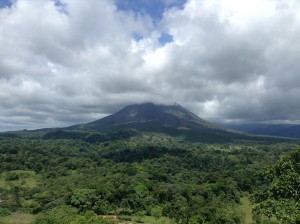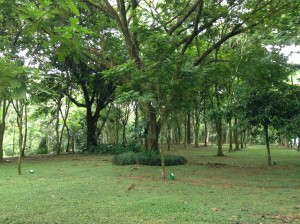 I have previously discussed the findings of a short and informal research conducted in Austin, TX to support a hypothesis claiming that people are more likely to engage in activities outdoors if the temperature is optimal, that is 73-78F. Previous research also suggests that people are more likely to help others (Guéguen, & Lamy, 2013) and take risks, particularly financial risks (Bassi, Colacito, & Fulghieri, 2013), during sunny weather conditions. This increased willingness to spontaneously help others and to take financial risks is associated with better moods induced by different weather conditions, particularly sunny days (Rind, 1996). However, one study found that preference for a particular characteristic of weather better predicted mood after exposure to rain, clouds, or sun (Klimstra et al., 2011).
I have previously discussed the findings of a short and informal research conducted in Austin, TX to support a hypothesis claiming that people are more likely to engage in activities outdoors if the temperature is optimal, that is 73-78F. Previous research also suggests that people are more likely to help others (Guéguen, & Lamy, 2013) and take risks, particularly financial risks (Bassi, Colacito, & Fulghieri, 2013), during sunny weather conditions. This increased willingness to spontaneously help others and to take financial risks is associated with better moods induced by different weather conditions, particularly sunny days (Rind, 1996). However, one study found that preference for a particular characteristic of weather better predicted mood after exposure to rain, clouds, or sun (Klimstra et al., 2011).
While identifying which aspects of weather most strongly influence mood and how they can impact behavior is under ongoing scientific scrutiny, the general assumption that weather and climate play an important role in human behavior is strongly supported by the literature. While observing the relationship between weather conditions, particularly temperature, and human behavior, I have been able to draw my own conclusions about the differences in lifestyles among Austinites and Costa Ricans.
Diet
Food is a basic need. The need for nutrients is one all organisms share. However, obesity among humans, unlike other species, has risen sharply over the past 30 years (Ljungvall, Zimmerman, 2008) and today, about half of the population of developed nations is considered overweight or obese (Colagiuri et al. 2010). Ferrer, Burge, Palmer, and Cruz (2016) explain the importance of assessing dieting behaviors from a perspective beyond the individual’s decision making processes, considering opportunity or feasibility as a defining factor of what a person eats.
In Costa Rica, fruits were abundant. Everywhere we visited had trees with papayas, mangos, or coconuts. One of these never failed to be present. Aside from these fruits, oranges, lemons, guanavanas, pineapples, guavas, avocados, and bananas could also be easily found around the country, or at least in the places we visited. In Costa Rica, fruits were accessible and affordable, if not free.
In Austin, an avocado half the size of those grown in Costa Rica can cost as much as $2.oo USD. I have paid up to $13.oo USD for less than two pounds of grapes (I should note this was an accident and I would not have bought the expensive grapes had I realized how much they were before I arrived home). The bottom line is that fruits are not particularly cheap in the United States with the exception of apples, and due to the changing seasons and extreme temperatures, growing different kinds of fruit trees is difficult, and growing a fruit tree in the U.S. to produce as much fruit as those in Costa Rica is almost impossible. On the other hand, fatty, sugary snacks and processed foods can be more easily accessed and afforded than fruits in the United States.
“When people have few opportunities, they often adjust their expectations downward, so that what appears to be poor motivation may be a logical response to a difficult environment” (Duflo, 2012). This explains how climate, by increasing the availably of healthy foods like fruits in places like Costa Rica, can influence behavior, leaning people towards healthier diets and predisposing others to less healthy eating habits that may result in diabetes, cancers, and mood disorders (Colagiuri et al. 2010).
Fashion
The average annual temperature in Costa Rica is between 70–81F (Costa Rica). Personally, and counterintuitively considering my discussion on perceived temperature in previous blogs, the temperature in Costa Rica often felt closer to the 90’s than anywhere near 70F. It could have been the humidity, the activities in which we were involved, or the amount of direct sunlight we received throughout the trip that caused everyone to feel so hot all the time. There were not many places with AC, some hotels even lacked this commodity. Due to these conditions, temperature often defined what we wore.
I wanted to wear tank tops, flip flops, and shorts all the time. Unfortunately that was not the case. I wore closed-toe shoes and t-shirts most of the time. Pants were recommended as well but I simply could not wear them while melting inside so much clothing. Costa Rica was hot and temperature was a consideration every time I decided what to wear.
Since the main reason for my trip to Costa Rica was to learn from the country about sustainable initiatives, I feel sustainable fashion is a topic worth discussing. McNeill and Moore (2015) identify two opposing motives that people who are environmentally invested might face when buying clothing, their desire to be fashionable and create a meaning for their image and the desire to act ethically and sustainably. While I did not spend enough time in Costa Rica to ensure that my judgment of the fashion industry there is accurate, from my short experience in the country I concluded that fashion in Costa Rica is not sustainable. However, the fashion industry in Costa Rica might be less wasteful than in the United States due to a weaker consumerist culture present in Costa Rica.
Activities
I will always remember my first time in the North Sea. It was cold. It was shocking to me because I had never been in cold salt water. It made little sense and I remember stubbornly getting in the water just to come out shaking half a minute later. That is the clearest example of how temperature becomes a defining factor when deciding what to do for fun. In Costa Rica, I did not hesitate to jump in the ocean. It was so refreshing considering how warm it felt outside, not to mention the water was also a relief from the mosquitos that relentlessly chased me around the Central American country.
Aside from an increased desire to be in the water, whether a pool, the ocean, or taking a shower, the higher temperatures, to a degree, incentivized more conservative displacements as seen in terrestrial isopods (Rojas, Castillo, Folgera, Abades, & Bozinovic, 2014). I found myself sitting often and looking for shaded places or places with AC. I tried to stay near drinkable water to maintain myself hydrated and avoided long exposure to the sun to prevent sunburns.
Values
Costa Rica was an amazing experience. Although growing and watching all of the other EcoLeaders grow with me was amazing and truly moving, what I found to be the most interesting was the attitude of locals towards sustainability and their approach to environmental problems. It seem to make sense to them that taking care of the environment is in their best interests. Unlike many people in the United States, Costa Ricans were willing to put the environment before them and sustainably benefit from it. I saw this mentality among children and adults alike, from the tour guide who studied ecology to the bartender studying psychology.
To see this values engraved in all Costa Ricans was inspirational and brings back some of the hope lost during the social projects that sought to educate the St. Edward’s community on sustainability. I also found that once common ground was set on the issue of environmental sustainability, social interaction became easier despite there being a language barrier for some people. The free flow of ideas allowed for mutual growth from both sides, pushing some to consider perspective they had not previously been exposed to.
Costa Ricans were always welcoming. Their hospitality and warmth stood out and made us feel confortable around them while at the same time keeping us accountable for our actions and our responsibility to behave as guests and respect their culture and traditions. This Costa Rican hospitality played a key role inviting us to submerge in the culture and being more open to new ideas and constructive criticism.
Sustainability
While Costa Rica may not be a “Green Republic,” it is one of the best examples the world has of a country leading on a more sustainable path. The top to bottom process of political decision-making has, for the most part, been fair to Costa Ricans, motivating its citizens to adhere to long-term sustainable practices by successfully meeting short-term goals. Such degree of success is only possible when the interests of the people align with the intentions of the government. Consensus between these two parties is what sets Costa Rica apart from many other nations where the interests of the people and the government are in conflict.
Leadership
By the end of this experience I can say with certainty that I am more in touch with my feelings and that I am now able to be more honest and compassionate with myself and with others. I cannot wait to be back in Austin, see everybody and keep building the relationships we started during our time in Costa Rica. I have a deeper appreciation for friends and how earthshaking it can be to meet someone for the first time over and over. Every new interaction with every single one of my classmates was always a surprise. I want to surround myself with more people like them, people with whom to shape the world together.
References
Bassi, A., Colacito, R., & Fulghieri, P. (2013). O Sole Mio: An experimental analysis of weather and risk attitudes in financial decisions. Review Of Financial Studies, 26(7), 1824.
Colagiuri, C. M., Lee, R., Colagiuri, D., Magliano, J. E., Shaw, P. Z., Zimmet, et al. (2010). The cost of overweight and obesity in Australia. Med. J. Aust, 192(5), 260-264.
Du O. E. ( 2012) Human Values and the Design of the Fight Against Poverty. Tanner Lectures, 1–55.
Costa Rica Weather. 2016. Retrieved from http://www.govisitcostarica.com/travelInfo/climate.asp
Guéquen, N., & Lamv, L. (2013). Weather and helping: additional evidence of the effect of the sunshine Samaritan. Journal Of Social Psychology, 153(2), 123-126.
Klimstra, T. A., Frijns, T., Keiisers, L., Denissen, J. A., Rajimakers, Q. W., Van Aken, M. G., … & Meeus, W. J. (2011). Come rain or come shine: Individual differences in how weather affets mood. Emotion, 11, 1595-1499.
Ljungvall A, Zimmerman F. J. (2012) Bigger bodies: long-term trends and disparities in obesity and body-mass index among U.S. adults, 1960-2008. Soc Sci Med. 75(1), 109-119.
McNeill, L., & Moore, R. (2015). Sustainable fashion consumption and the fast fashion conundrum: fashionable consumers and attitudes to sustainability in clothing choice. International Journal Of Consumer Studies, 39(3), 212-222. doi: 10.1111/ijcs.12169
Rind, B. (1996). Effect of beliefs about weather conditions on tipping. Journal of Applied Social Psychology, 26, 137–147. doi: 10.1111/j.1559-1816.1996.tb01842.x
Rojas, J. M., Castillo, S. B., Folguera, G., Abades, S., & Bozinovic, F. (2014). Coping with Daily Thermal Variability Behavioral Performance of an Ectotherm Model in a Warming World. Plos ONE. 9(9). 1-9. Doi:10.1371/journal.pone.0106897
